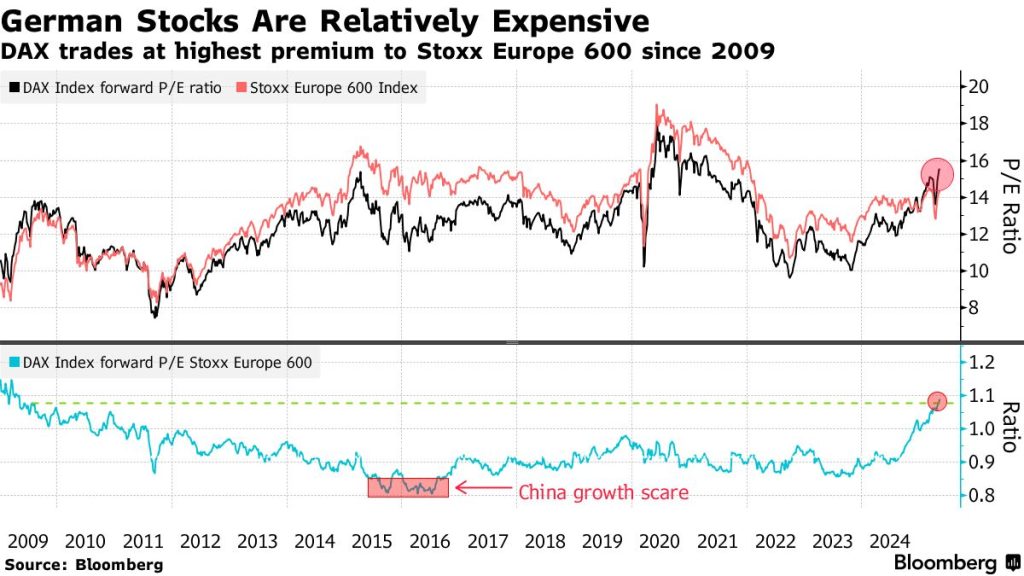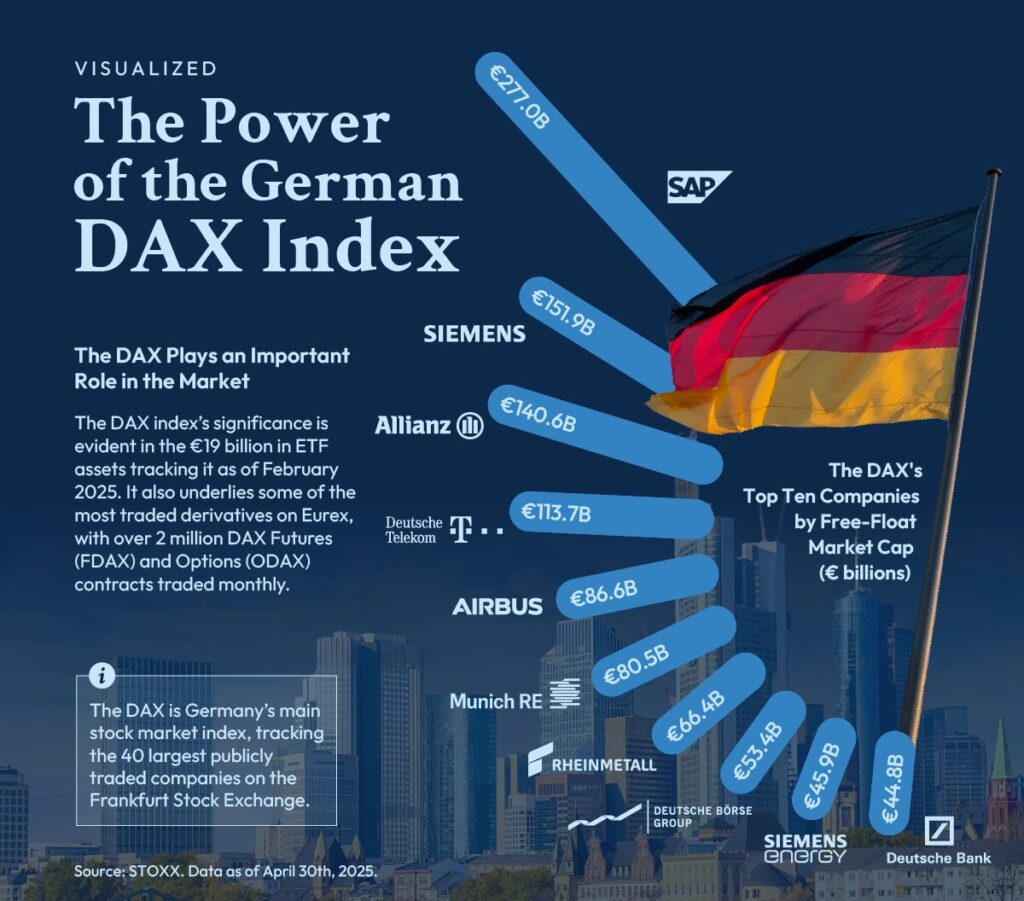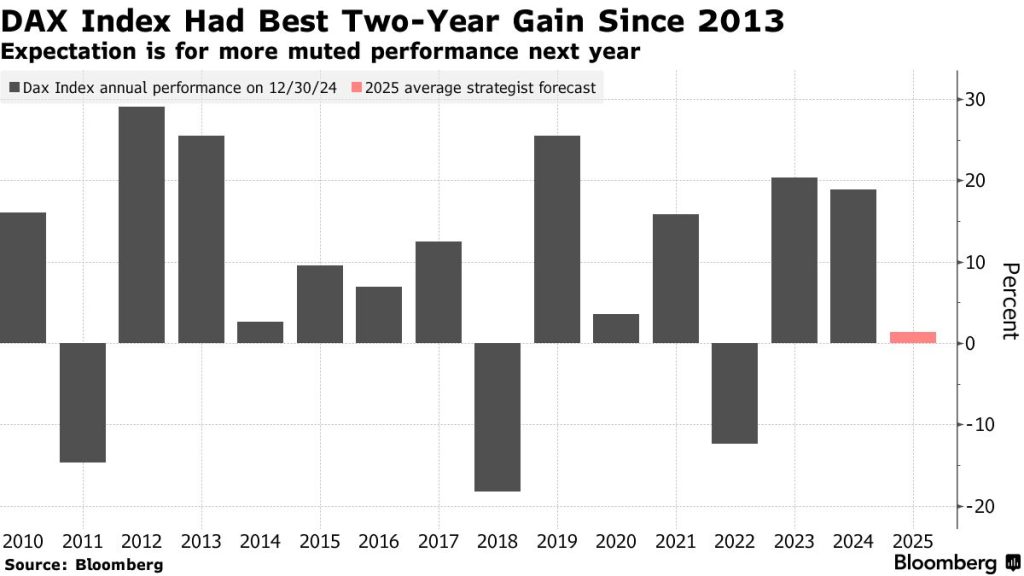
When traders talk about the big names in global stock markets, the DAX 40 is often near the top of the list. Known as Germany’s leading index, it represents the strength of Europe’s largest economy and is closely watched by investors around the world.
Whether you are completely new to trading or already exploring global indices, understanding the DAX 40 can open up exciting opportunities.
What is the DAX 40?
The DAX 40, short for Deutscher Aktienindex, is Germany’s benchmark stock index. It tracks the performance of the 40 largest and most actively traded companies listed on the Frankfurt Stock Exchange.
These companies represent a wide cross-section of industries – from automotive and finance to technology and chemicals.
Household names such as Siemens, BMW, Allianz, and SAP are all part of the DAX. As such, it provides a clear snapshot of how Germany’s corporate giants are performing.
To put the DAX into context, you can think of it as Europe’s equivalent of the S&P 500 in the United States or the FTSE 100 in the United Kingdom. Like those indices, it is not only a measure of economic strength but also a tradable instrument in its own right.

Why traders pay attention to the DAX 40
There are two key reasons why traders worldwide keep a close eye on the DAX: volatility and influence.
Firstly, the DAX is known for its volatility. This means prices can move significantly within a single trading session, creating opportunities for both short- and medium-term traders. Liquidity is also strong, which makes it easier to enter and exit positions without large price slippage.
Secondly, the index reflects more than just German companies. Germany is the largest economy in Europe, so the DAX acts as a proxy for European economic health. It often responds not only to local data but also to global events.
For instance, an interest rate decision by the European Central Bank (ECB) or a policy shift by the US Federal Reserve can send the DAX moving sharply in either direction.
How the DAX 40 is traded
Unlike buying a single company’s stock, trading the DAX means speculating on the overall direction of the index. There are several ways to do this:
- Contracts for Difference (CFDs): The most accessible route for retail traders. With CFDs, you can go long (buy) if you expect the DAX to rise, or go short (sell) if you expect it to fall.
- Futures and options: More advanced financial instruments, often used by institutional or experienced traders.
- Exchange-traded funds (ETFs): A simpler option for longer-term investors who want to track the index without active trading.
For example, imagine that Germany reports stronger-than-expected car manufacturing data, boosting confidence in BMW and Volkswagen. A trader could speculate that the DAX will rise and open a long CFD position. Conversely, if weak industrial output is reported, the same trader might choose to short the index.

Factors influencing the DAX 40
The DAX is sensitive to a wide range of factors. For new traders, understanding what drives its movements is crucial:
- Economic data: German GDP growth, unemployment figures, and manufacturing PMI reports can all affect the index.
- European Central Bank policy: Decisions on interest rates or bond-buying programmes often have a direct impact on European equities.
- Global events: As a highly industrialised economy, Germany is vulnerable to changes in energy prices, trade tensions, and geopolitical risks.
- Company earnings: Results from large firms such as Siemens, Volkswagen, or SAP can move the index noticeably.
For instance, a sharp rise in oil and gas prices could weigh heavily on energy-dependent German industries, dragging down the DAX overall. On the other hand, positive quarterly results from several leading companies can lift the index, even in the face of broader economic uncertainty.
Practical strategies for trading the DAX 40
When it comes to trading the DAX, beginners should focus on simple, structured strategies that balance opportunity with risk control.
Trend following: Many traders use moving averages, such as the 50-day or 200-day, to identify the overall direction. If the index is trading above a moving average, it may suggest a bullish trend; below it may suggest bearish momentum.
Breakout trading: The DAX often respects clear support and resistance levels. Traders can look for price to “break out” of these ranges, signalling a potential strong move.
News-based trading: Given its sensitivity to announcements, trading around ECB meetings, major corporate earnings, or global economic updates can present opportunities.
Risk management is non-negotiable. Stop-loss orders should always be used to protect against sudden reversals. Position sizes should remain small enough that a single losing trade does not damage your account significantly.
Finally, practising on a demo account before moving to live trading is strongly recommended. It allows beginners to learn how the DAX behaves without putting real money at risk.

Risks and things to keep in mind
The DAX’s volatility makes it exciting, but also risky. Price moves can be sharp and sudden, particularly during economic announcements.
Leverage – a feature of CFDs – can magnify gains but also magnify losses. Traders should therefore use it cautiously.
The index is most active during European and US trading hours, which is when liquidity and volatility are at their peak.
Above all, discipline and emotional control are vital. Sticking to a clear plan helps prevent impulsive decisions.
Conclusion
The DAX 40 is more than just Germany’s leading stock index – it is a powerful reflection of European economic health and a dynamic trading instrument in its own right. For new traders, it offers exposure to multiple sectors, regular price movement, and plenty of opportunities to learn.
The key is to start small, practise diligently, and always manage risk. Ready to put your knowledge into action? Open a live account with VT Markets today and experience trading the DAX 40 with professional tools, competitive spreads, and dedicated support.





